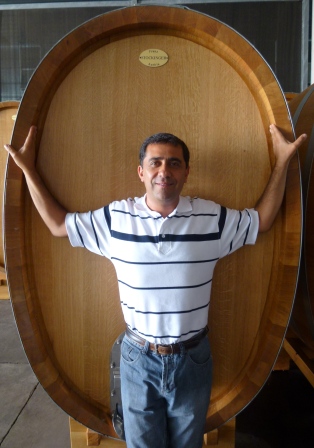Chile hots up
(by peter)
 News from Chile on two fronts.
News from Chile on two fronts.
First up, in somewhat blushing fashion, a link to a very nice profile on me which appeared last weekend in Chilean broadsheet El Mercurio’s Wiken magazine, written by distinguished Chilean writer Patricio Tapia.
As a word of warning, the article is in Spanish and also features a startling large picture of me. It’s also reproduced on a separate site in image format as it’s difficult to access the original article on El Mercurio’s site from abroad.
Secondly, and far more importantly, word is reaching me of a very warm, and potentially very early harvest in Chile this year.
After two years of long, dry, relatively late harvests, affected by La Niña, Chile is experiencing a summer heat wave.
Marcelo Retamal, winemaker at De Martino, who oversees vineyards all over Chile, has been startled by the climate.
‘It’s incredible: the warmest March I’ve ever seen since I started making wine,’ he comments. ‘It’s not a year you want to follow the historical record. Normally, Maipo Cabernet is picked in mid-April or early May; if you do that this year you’ll end up with raisins.’
Retamal notes that temperatures in the capital Santiago have been over 30 degrees Centigrade for the past two weeks, an uncommon occurrence.
‘I’m already picking my top Maipo Cabernet this week, at 13-13.5% alcohol. I think we’ll be pretty much wrapped up in April this year.’
(One of Chile’s most respected and pioneering winemakers, Retamal has been pursuing a policy of early harvesting since the 2011 vintage. Allied to a daring policy eschewing new oak, cultured yeasts and other common ‘standardising influences’, Retamal is a man on a mission to craft drinkable, elegant, refreshing fine red wines from Chile. I visited in January to taste the 2011s, which were a resounding success and total vindication of this policy – look out for my full report coming soon.)
 Other winemakers and viticulturists attest to the strange and challenging nature of 2012 in Chile. While the far south seems to have been largely unaffected, most other regions are 2-3 weeks ahead of normal, the majority of whites having been harvested and the reds now in full swing.
Other winemakers and viticulturists attest to the strange and challenging nature of 2012 in Chile. While the far south seems to have been largely unaffected, most other regions are 2-3 weeks ahead of normal, the majority of whites having been harvested and the reds now in full swing.
Although both 1999 and 2003 were notably warm vintages, nothing like this sustained heat has affected Chile in recent memory. As a result, this will be a testing vintage, and success will be the result of viticultural expertise (irrigation technique and canopy management will be key) and deft winemaking (gentle extraction in case tannins aren’t completely ripe).
Early estimates had volumes up on the last two low-yielding vintages but this has now been revised back down, which won’t please the accountants. But whether winemaker or bean counter, everyone is anxious about 2012, and it looks set to be a very different vintage from the norm.
(As a postcript, on the other side of the Andes in Argentina it’s shaping up to be a decent vintage, slightly warmer than 2011, but the main story being volumes significantly reduced due to a windy, rainy, cool spring. Edy del Popolo at Dona Paula notes that official estimates have San Juan and East Mendoza down by 20-30%, while his own Gualtallary vineyard is down 50% compared to 2011.)
My thanks to Eduardo Moraga of El Mercurio for sharing his mid-vintage report; also to Marcelo Retamal, Hector Rojas, Ana Maria Cumsille, Sven Bruchfeld and Edy del Popolo for their input.
